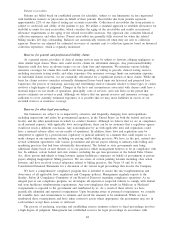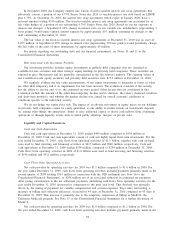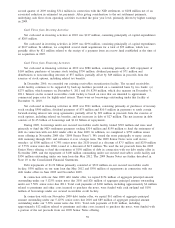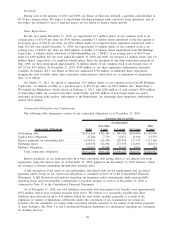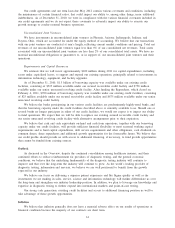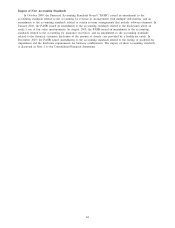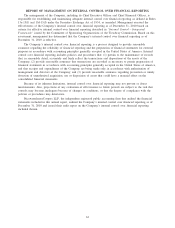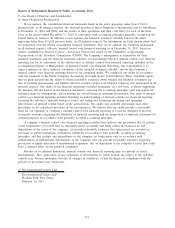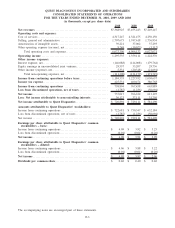Quest Diagnostics 2010 Annual Report Download - page 61
Download and view the complete annual report
Please find page 61 of the 2010 Quest Diagnostics annual report below. You can navigate through the pages in the report by either clicking on the pages listed below, or by using the keyword search tool below to find specific information within the annual report.In November 2009, the Company entered into various fixed-to-variable interest rate swap agreements that
effectively convert a portion of our 4.75% Senior Notes due 2020 to variable-interest rate debt based on LIBOR
plus 1.33%. At December 31, 2010, the interest rate swap agreements which expire in January 2020, have a
notional amount totaling $350 million. The fixed-to-variable interest rate swap agreements are accounted for as
fair value hedges of a portion of our outstanding 4.75% Senior Notes due 2020. Based on our net exposure to
interest rate changes, a hypothetical 10% change in interest rates on our variable rate indebtedness (representing 3
basis points) would impact annual interest expense by approximately $0.3 million, assuming no changes to the
debt outstanding at December 31, 2010.
The fair value of the fixed-to-variable interest rate swap agreements at December 31, 2010 was an asset of
$10.5 million. A hypothetical 10% change in interest rates (representing 30 basis points) would potentially change
the fair value of the asset of these instruments by approximately $9 million.
For details regarding our outstanding debt and our financial instruments, see Notes 10 and 11 to the
Consolidated Financial Statements.
Risk Associated with Investment Portfolio
Our investment portfolio includes equity investments in publicly held companies that are classified as
available-for-sale securities and other strategic equity holdings in privately held companies. These securities are
exposed to price fluctuations and are generally concentrated in the life sciences industry. The carrying values of
our available-for-sale equity securities and privately held securities were $17.6 million at December 31, 2010.
We regularly evaluate the fair value measurements of our equity investments to determine if losses in value
are other than temporary and if an impairment loss has been incurred. The evaluation considers if the security
has the ability to recover and, if so, the estimated recovery period. Other factors that are considered in this
evaluation include the amount of the other-than-temporary decline and its duration, the issuer’s financial condition
and short-term prospects, and whether the market decline was caused by overall economic conditions or
conditions specific to the individual security.
We do not hedge our equity price risk. The impact of an adverse movement in equity prices on our holdings
in privately held companies cannot be easily quantified, as our ability to realize returns on investments depends
on, among other things, the enterprises’ ability to raise additional capital or derive cash inflows from continuing
operations or through liquidity events such as initial public offerings, mergers or private sales.
Liquidity and Capital Resources
Cash and Cash Equivalents
Cash and cash equivalents at December 31, 2010 totaled $449 million compared to $534 million at
December 31, 2009. Cash and cash equivalents consist of cash and highly liquid short-term investments. For the
year ended December 31, 2010, cash flows from operating activities of $1.1 billion, together with cash on-hand,
were used to fund investing and financing activities of $217 million and $986 million, respectively. Cash and
cash equivalents at December 31, 2009 totaled $534 million, compared to $254 million at December 31, 2008.
Cash flows from operating activities in 2009 of $1.0 billion were used to fund investing and financing activities
of $196 million and $521 million, respectively.
Cash Flows from Operating Activities
Net cash provided by operating activities for 2010 was $1.1 billion compared to $1.0 billion in 2009. For
the year ended December 31, 2009, cash flows from operating activities included payments primarily made in the
second quarter of 2009 totaling $314 million in connection with the NID settlement (see Note 16 to the
Consolidated Financial Statements), or $208 million net of an associated reduction in estimated tax payments.
After giving consideration to the net settlement payments, underlying cash flows from operating activities for the
year ended December 31, 2010 decreased in comparison to the prior year level. This decrease was primarily
driven by the timing of payments for variable compensation and accrued expenses. Days sales outstanding, a
measure of billing and collection efficiency, increased to 44 days at December 31, 2010 compared to 43 days at
December 31, 2009. This increase is primarily due to the temporary suspension of billing to MediCal, the
California Medicaid program. See Note 15 to the Consolidated Financial Statements for a further discussion of
MediCal.
Net cash provided by operating activities for 2009 was $1.0 billion compared to $1.1 billion in 2008. For
the year ended December 31, 2009, cash flows from operating activities includes payments primarily made in the
58


